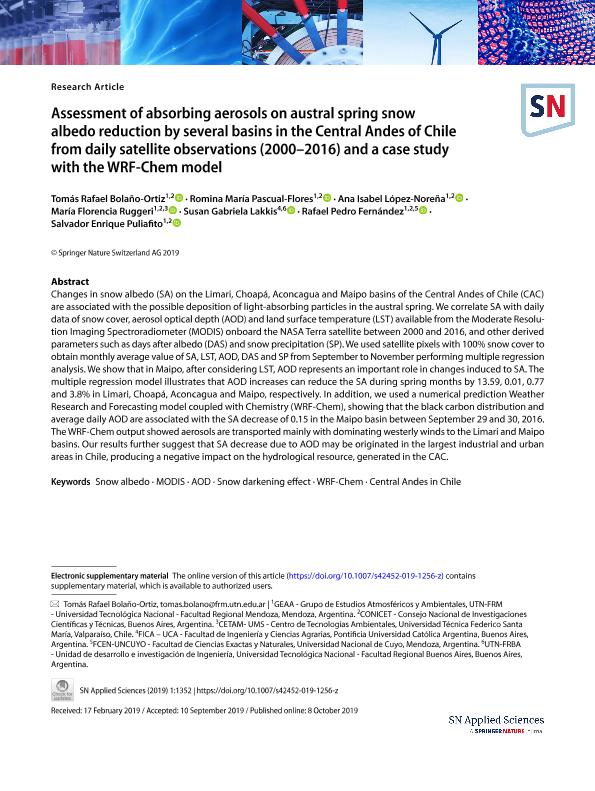Artículo
Assessment of absorbing aerosols on austral spring snow albedo reduction by several basins in the Central Andes of Chile from daily satellite observations (2000–2016) and a case study with the WRF-Chem model
Bolaño Ortiz, Tomas Rafael ; Pascual Flores, Romina María
; Pascual Flores, Romina María ; Lopez Noreña, Ana Isabel
; Lopez Noreña, Ana Isabel ; Ruggeri, María Florencia
; Ruggeri, María Florencia ; Lakkis, Susan Gabriela; Fernandez, Rafael Pedro
; Lakkis, Susan Gabriela; Fernandez, Rafael Pedro ; Puliafito, Salvador Enrique
; Puliafito, Salvador Enrique
 ; Pascual Flores, Romina María
; Pascual Flores, Romina María ; Lopez Noreña, Ana Isabel
; Lopez Noreña, Ana Isabel ; Ruggeri, María Florencia
; Ruggeri, María Florencia ; Lakkis, Susan Gabriela; Fernandez, Rafael Pedro
; Lakkis, Susan Gabriela; Fernandez, Rafael Pedro ; Puliafito, Salvador Enrique
; Puliafito, Salvador Enrique
Fecha de publicación:
10/2019
Editorial:
Springer
Revista:
SN Applied Sciences
ISSN:
2523-3971
e-ISSN:
2523-3963
Idioma:
Inglés
Tipo de recurso:
Artículo publicado
Clasificación temática:
Resumen
Changes in snow albedo (SA) on the Limari, Choapá, Aconcagua and Maipo basins of the Central Andes of Chile (CAC) are associated with the possible deposition of light-absorbing particles in the austral spring. We correlate SA with daily data of snow cover, aerosol optical depth (AOD) and land surface temperature (LST) available from the Moderate Resolution Imaging Spectroradiometer (MODIS) onboard the NASA Terra satellite between 2000 and 2016, and other derived parameters such as days after albedo (DAS) and snow precipitation (SP). We used satellite pixels with 100% snow cover to obtain monthly average value of SA, LST, AOD, DAS and SP from September to November performing multiple regression analysis. We show that in Maipo, after considering LST, AOD represents an important role in changes induced to SA. The multiple regression model illustrates that AOD increases can reduce the SA during spring months by 13.59, 0.01, 0.77 and 3.8% in Limari, Choapá, Aconcagua and Maipo, respectively. In addition, we used a numerical prediction Weather Research and Forecasting model coupled with Chemistry (WRF-Chem), showing that the black carbon distribution and average daily AOD are associated with the SA decrease of 0.15 in the Maipo basin between September 29 and 30, 2016. The WRF-Chem output showed aerosols are transported mainly with dominating westerly winds to the Limari and Maipo basins. Our results further suggest that SA decrease due to AOD may be originated in the largest industrial and urban areas in Chile, producing a negative impact on the hydrological resource, generated in the CAC.
Palabras clave:
AOD
,
CENTRAL ANDES IN CHILE
,
MODIS
,
SNOW ALBEDO
,
SNOW DARKENING EFFECT
,
WRF-CHEM
Archivos asociados
Licencia
Identificadores
Colecciones
Articulos(CCT - MENDOZA)
Articulos de CTRO.CIENTIFICO TECNOL.CONICET - MENDOZA
Articulos de CTRO.CIENTIFICO TECNOL.CONICET - MENDOZA
Citación
Bolaño Ortiz, Tomas Rafael; Pascual Flores, Romina María; Lopez Noreña, Ana Isabel; Ruggeri, María Florencia; Lakkis, Susan Gabriela; et al.; Assessment of absorbing aerosols on austral spring snow albedo reduction by several basins in the Central Andes of Chile from daily satellite observations (2000–2016) and a case study with the WRF-Chem model; Springer; SN Applied Sciences; 1; 11; 10-2019; 1-13
Compartir
Altmétricas



